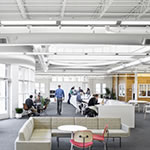Virtual workplaces and electronic communication, both embraced in the name of efficiency, have reduced the number of employees working in a physical office. So why is the parking lot at Herman Miller’s Design Yard in Holland, Michigan, getting more and more crowded?
According to Greg Parsons, the contract furniture company’s vice president of New Work Landscape, it has to do with a fundamental change happening in workplaces, which boils down to a realization that people like being with other people. Particularly for organizations that require creativity, those human connections are productivity boosters. “Creativity used to be a dark mystery,” Parsons says. “But neuroscience is telling us a lot more about how the human brain works. We now understand certain physiological processes that drive work performance.”

Three semi-enclosed Haven layouts provide a quiet place to focus on one project or to take a private phone call when needed.

People move from individual to collaborative work throughout their day. Technology-enabled Coves, such as this bar-height table and monitor with screen-sharing technology, near workstations provide places to congregate for informal meetings.
Traditional office configurations, which Parsons says attempt a “mechanistic, mass-scale of efficiency,” fail to enhance users’ individual tasks or collaboration. Long a company that studied the nature of office environments, Herman Miller undertook research in 2012 that identified different modes by which employees optimally work—both solo and together.
From this study, the company developed the Living Office, a framework composed of 10 prototypical settings that serve the purposes, character, and activities of contemporary work. These settings are gradually being integrated into the Design Yard, which consolidates the various stages of the furniture manufacturing process into one 200,000-square-foot building. The exercise not only helps inform the design side of Herman Miller’s line, but also allows the firm to speak from experience when advising clients.

The interchangeable settings of Herman Miller’s new Living Office are designed to accommodate different types of interaction and solo work.
Parsons believes the Design Yard’s crowded parking lot is due in part to its Plaza setting, which is a combination kitchen and family room. Anchored by a coffee bar and a 40-foot-long table inviting employees from all locations in western Michigan, the Plaza is a welcoming environment for employees, vendors, clients, and visitors to informally huddle, chat, and get coffee. Parsons says visitors often stay longer than their official appointment, enjoying the relaxed atmosphere and easy conversation.
Other settings include Forum and Workshop, the former designed largely for a sole presenter while the latter is more about free-form interaction between participants. “With a Workshop, people might dance around a white board,” Parsons says—try doing that in an email thread. The remaining seven Living Office settings (Haven, Hive, Jump Space, Clubhouse, Cove, Meeting Space, and Landing) accommodate different types of interaction and solo work.

This Plaza setting is furnished with the recently unveiled Public Office Furniture, designed by Yves Behar of fuseproject. See more of Herman Miller’s latest furniture at NeoCon in Chicago this June.
Not forgetting the impact of having healthful as well as productive working environments, Herman Miller has a Design for Environment team that conducts research on life-cycle product assessments, material chemistry, disassembly and recyclability, recycled content, and off-gassing for all its products. Thus, an architect or designer can easily find a product’s sustainability documentation through the Herman Miller catalog or a customer RFP.
Green interiors and new products may well be part of the buzz happening at the Design Yard’s Plaza, but interestingly, it’s the advanced technology—wireless laptops and floating phone systems—that enables this varied work atmosphere. Work and workers are no longer secluded at home or tethered to a wall; they’re creating real connections at the office.

